Acelerar la eliminación de enfermedades
Capítulo 1. Panorama de la Iniciativa de Eliminación de Enfermedades
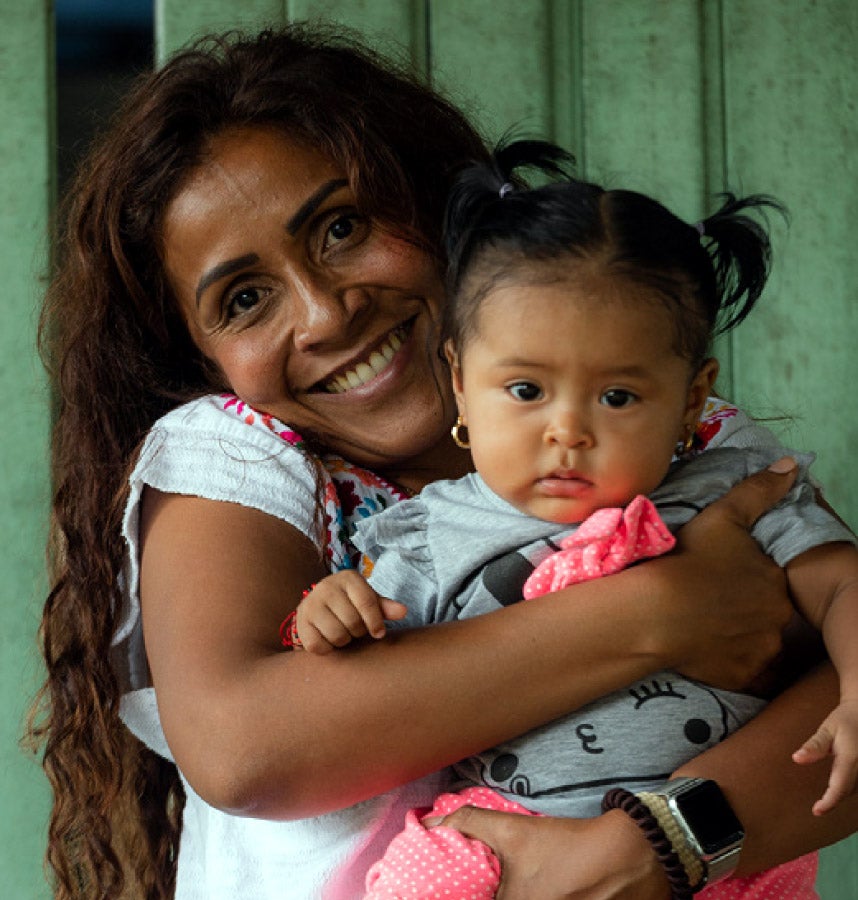
Resumen
La Iniciativa de Eliminación de Enfermedades es un marco integral cuya finalidad es eliminar más de 30 enfermedades transmisibles y condiciones relacionadas en la Región de las Américas para el 2030. El trabajo de la Organización Panamericana de la Salud (OPS) está profundamente arraigado en la eliminación de enfermedades, y la iniciativa se basa en más de 120 años de esfuerzos en el ámbito de la salud pública. Con un enfoque integrado y multisectorial para abordar los complejos patrones de transmisión de enfermedades, la iniciativa se centra en cuatro áreas clave: 1) fortalecer la integración de los sistemas de salud y la prestación de servicios de salud, 2) fortalecer los sistemas estratégicos de información y vigilancia de salud, 3) abordar los determinantes sociales y ambientales de la salud, y 4) fortalecer la gobernanza, la rectoría y las finanzas. En esta iniciativa se hace hincapié en la equidad y en los grupos poblacionales en situación de vulnerabilidad, además de que se tiene en cuenta todo el curso de vida en su enfoque.
A penas unos pocos meses tras su puesta en marcha, la pandemia de COVID-19 hizo que disminuyera el ritmo de avance. A pesar de que se ha reanudado el progreso después de la pandemia, otras barreras aún amenazan con frenar la tarea de eliminación de enfermedades, como la migración, el aumento de las enfermedades no transmisibles, las inequidades en la salud, el cambio climático y las limitaciones de recursos. A pesar de estos obstáculos, han surgido también algunas oportunidades aceleradas por la pandemia de COVID-19, como la mejora de la tecnología, la mayor conciencia de los determinantes sociales de la salud y las innovaciones en la prestación de servicios. La Iniciativa de Eliminación de Enfermedades proporciona un marco estructurado para que los países aprovechen estas oportunidades y aborden su contexto y prioridades específicos en la lucha contra las enfermedades transmisibles.
¿Por qué se creó la Iniciativa de Eliminación de Enfermedades y por qué se la puso en marcha ahora?
En la década del 2010, la Región de las Américas se encontraba en una encrucijada en lo que respecta a la eliminación de las enfermedades transmisibles. Si bien la OPS y sus Estados Miembros habían tenido mucho éxito en la lucha contra ciertas enfermedades, en particular algunas enfermedades prevenibles mediante vacunación como la rubéola y el sarampión, estaban surgiendo nuevos problemas o tornándose aún más urgentes. A pesar de los avances en la mejora de los sistemas de salud, el desarrollo de nuevas tecnologías y el fortalecimiento de alianzas multisectoriales, había más contratiempos y desafíos que nunca. El cambio climático, la reticencia a la vacunación, las desigualdades en el acceso a servicios de salud y las nuevas enfermedades infecciosas son solo algunas de las áreas críticas que enfrentaba la Región a fines de esa década. Era evidente que las medidas habituales no bastaban para hacer frente a los complejos patrones de transmisión de enfermedades que seguían siendo una carga para la Región.
Aunque algunos programas abordaban múltiples enfermedades al mismo tiempo, se seguía haciendo frente a muchas enfermedades de manera aislada. La OPS y sus Estados Miembros reconocieron la necesidad de un marco más ambicioso y abarcador para integrar los servicios a una escala más amplia. En ese contexto, bajo el liderazgo de la ex Directora Carissa Etienne, la OPS adoptó una iniciativa nueva y audaz, que aportó estructura y pragmatismo al complejo problema de la eliminación de enfermedades transmisibles. La iniciativa aprovechó las estructuras existentes (sistemas, tecnología, programas integrados y amplias coaliciones de partes interesadas) y agregó un marco integral que vinculó los sistemas para hacer frente a más de 30 enfermedades y condiciones en un marco general. También puso en primer plano un enfoque centrado en la comunidad y en la persona, a fin de que los Estados Miembros no dejaran a nadie atrás en sus esfuerzos para vencer las enfermedades transmisibles en toda la Región.
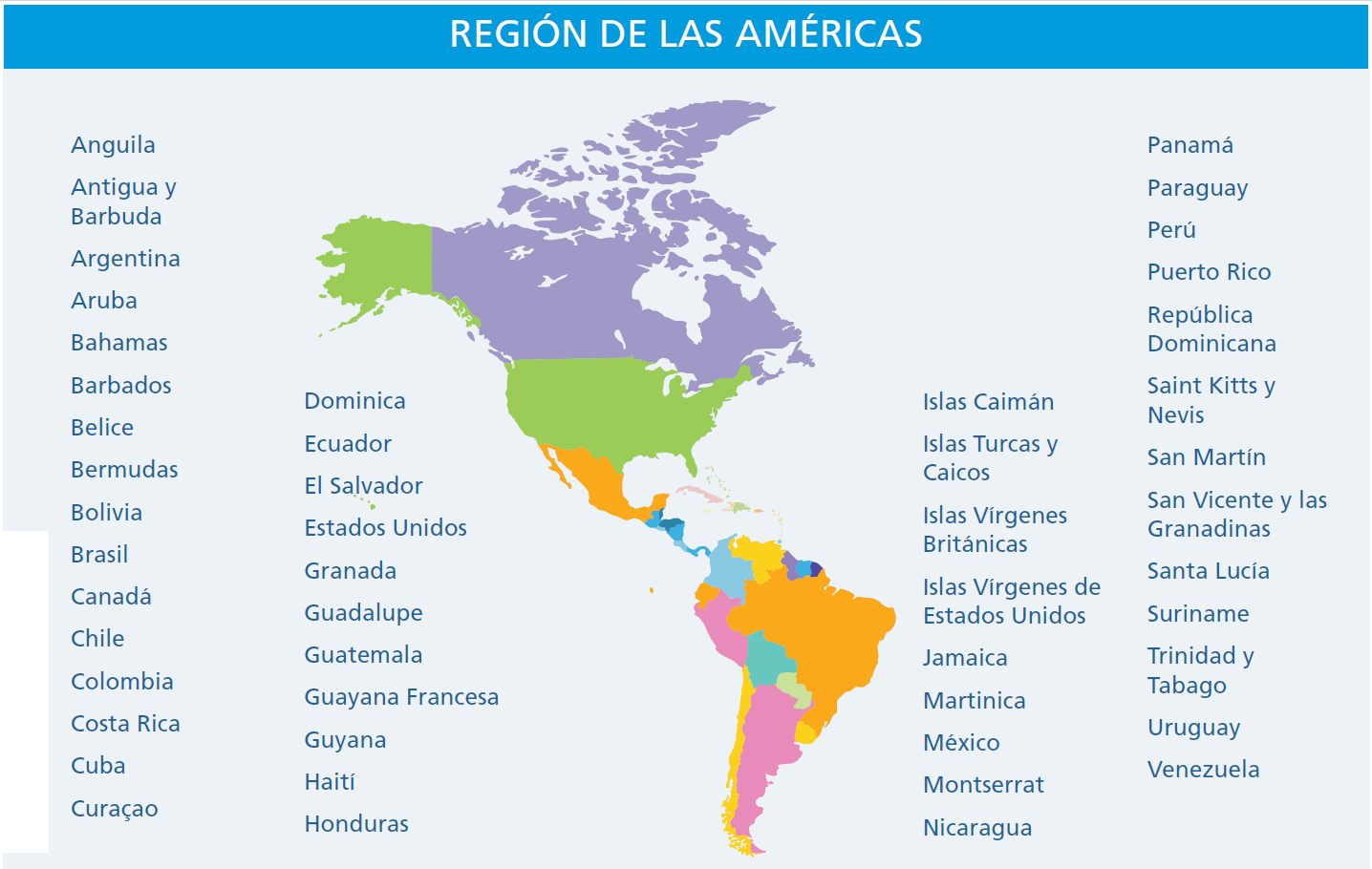
Cómo se estableció la Iniciativa de Eliminación de Enfermedades
En varias convocatorias importantes, entre ellas la Consulta Regional del 2015sobre la Eliminación de Enfermedades en la Región de las Américas, se expusieron argumentos a favor de la eliminación de múltiples enfermedades y se generó impulso para iniciar la tarea. Con el liderazgo de la OPS, los expertos regionales elaboraron el plan de lo que se convertiría en la Iniciativa de Eliminación de Enfermedades. A diferencia de los programas anteriores, esta iniciativa fue concebida no solo para combinar enfermedades con modos de transmisión similares (por ejemplo, la sífilis y la infección por el VIH), sino también para abordar amplias categorías de enfermedades y condiciones causantes de las mayores cargas de enfermedad en la Región.
En definitiva, la OPS y sus Estados Miembros incluyeron más de 30 enfermedades y condiciones en la Iniciativa de Eliminación de Enfermedades, que fue aprobada por el Consejo Directivo de la OPS en septiembre del 2019. Su ratificación estuvo en consonancia con los compromisos de los Estados Miembros de la OPS con respecto a políticas conexas de desarrollo y salud, entre ellas la Agenda 2030 para el Desarrollo Sostenible (en la que se establecieron los Objetivos de Desarrollo Sostenible) y la Agenda de Salud Sostenible para las Américas 2018-2030. (1, 2).
 © OPS
© OPS
En marzo del 2020, solo seis meses después de la puesta en marcha de la iniciativa, la Organización Mundial de la Salud (OMS) declaró que la COVID-19 era una emergencia mundial. La escalada repentina de la pandemia provocó graves perturbaciones en la vida cotidiana, desbordó los sistemas de salud de muchos países (y redujo el acceso y la disponibilidad de servicios de salud no relacionados con la COVID 19), interrumpió las cadenas de suministro, y desencadenó una crisis económica por el cierre de los comercios y el aumento del desempleo. Con un alto número de casos y muertes en toda la Región de las Américas, la COVID-19 también expuso y exacerbó las desigualdades existentes.
 Si bien la COVID-19 puso de manifiesto las deficiencias de los sistemas de salud, también ofreció nuevas oportunidades para prestar servicios más integrales. Con esto en mente, el actual Director de la OPS, Jarbas Barbosa da Silva, Jr., ratificó y reactivó la Iniciativa de Eliminación de Enfermedades en el 2023. Esta atención renovada a la iniciativa se convirtió en una oportunidad crucial para impulsar a los Estados Miembros no solo a fortalecer los sistemas para encarar mejor la eliminación de las enfermedades transmisibles, sino también a recuperarse de los reveses sufridos durante la pandemia. En la etapa pospandemia, las medidas integradas de eliminación de múltiples enfermedades pueden, en última instancia, ayudar a los países a reanudar y acelerar el progreso hacia la salud universal.
Si bien la COVID-19 puso de manifiesto las deficiencias de los sistemas de salud, también ofreció nuevas oportunidades para prestar servicios más integrales. Con esto en mente, el actual Director de la OPS, Jarbas Barbosa da Silva, Jr., ratificó y reactivó la Iniciativa de Eliminación de Enfermedades en el 2023. Esta atención renovada a la iniciativa se convirtió en una oportunidad crucial para impulsar a los Estados Miembros no solo a fortalecer los sistemas para encarar mejor la eliminación de las enfermedades transmisibles, sino también a recuperarse de los reveses sufridos durante la pandemia. En la etapa pospandemia, las medidas integradas de eliminación de múltiples enfermedades pueden, en última instancia, ayudar a los países a reanudar y acelerar el progreso hacia la salud universal.
Recuadro 1. ¿Qué es un “enfoque integrado” de la eliminación de enfermedades?
El término “enfoque integrado” se utiliza a lo largo de todo el informe. En la práctica, significa abordar múltiples áreas y servicios de salud conjuntamente para maximizar los resultados en materia de salud. Según la OMS, los servicios integrados de salud son aquellos que se administran y se prestan con el fin de que las personas reciban atención continua orientada a la promoción de la salud, la prevención, el diagnóstico, el tratamiento, el manejo de enfermedades, la rehabilitación y los servicios paliativos, todo ello de manera coordinada entre los distintos niveles y establecimientos del sector de la salud y de otros sectores, de acuerdo con las necesidades que tengan durante el curso de su vida.a
Los enfoques integrados pueden manifestarse de diversas maneras y pueden incluir la combinación de la prestación de servicios en un mismo lugar, la promoción de las derivaciones y la vinculación entre los prestadores, la combinación de las tareas de seguimiento y vigilancia, y la promoción de políticas multisectoriales centradas en las necesidades de las personas en el contexto en el que viven.
A continuación se presentan algunos ejemplos de enfoques integrados relacionados con la eliminación de enfermedades:
- definir los contenidos y priorizar el enfoque de realizar pruebas y proporcionar tratamiento en la misma consulta en el nivel de atención primaria de salud, y fortalecer los sistemas de derivación;
- combinar el seguimiento y la vigilancia de diferentes enfermedades y temas de salud;
- aprovechar las intervenciones en los hospitales de maternidad para vacunar o examinar a los recién nacidos, así como para examinar y tratar a las mujeres embarazadas y a los recién nacidos para detectar enfermedades de transmisión maternoinfantil;
- capacitar al personal de los consultorios de salud sexual y reproductiva para examinar, tratar y prevenir la infección por el VIH, la sífilis y otras infecciones de transmisión sexual (ITS), la hepatitis B y C, el cáncer relacionado con la infección por el virus del papiloma humano (VPH) y la tuberculosis;
- integrar el agua, el saneamiento y la higiene en las iniciativas de vivienda para mejorar las condiciones de vida que influyen en múltiples enfermedades;
- implementar enfoques costo-efectivos en el control integrado de vectores para controlar las enfermedades de transmisión vectorial;
- considerar el impacto del manejo de las enfermedades crónicas transmisibles en la eliminación de las enfermedades transmisibles;
- reconocer las conexiones entre la salud de las personas, los animales y el entorno común por medio del enfoque de “Una salud”;
- desplegar consultorios móviles y equipos médicos para evitar los problemas de transporte que pueden impedir que las personas lleguen a los establecimientos de salud;
- incorporar las prácticas tradicionales de sanación en los sistemas de salud para reconocer y abordar cuestiones interculturales.
a Organización Mundial de la Salud. Marco sobre servicios de salud integrados y centrados en la persona: Informe de la Secretaría [documento A69/39]. 69.a Asamblea Mundial de la Salud. Ginebra: OMS; 2016. Disponible en: https://apps.who.int/gb/ebwha/pdf_files/WHA69/A69_39-sp.pdf.
¿Por qué es importante adoptar un “enfoque integrado” para la eliminación de enfermedades?
El marco de la Iniciativa de Eliminación de Enfermedades implica movilizar a todo el sistema de salud para que los programas y servicios no operen en compartimentos estancos. En el enfoque que se aplica en esta iniciativa también se consideran las necesidades específicas de cada entorno y grupo poblacional, al tiempo que se contextualizan los problemas transfronterizos y regionales que afectan los programas de salud y las medidas de eliminación de enfermedades. Por último, una de las razones más importantes para utilizar un enfoque integrado es ofrecer una atención más centrada en la comunidad y en la persona, orientada no a las enfermedades en sí, sino a las personas y comunidades más afectadas por ellas.
En la Región de las Américas hay un gran número de enfermedades transmisibles y condiciones relacionadas de gran alcance. Por lo tanto, la iniciativa abarca enfermedades que representan una carga significativa y afectan de manera desproporcionada a las comunidades en situación de vulnerabilidad, entre ellas las poblaciones indígenas y afrodescendientes; las personas lesbianas, gais, bisexuales y trans (LGBT), y la población migrante. Al formular la política, la OPS también dio prioridad a las enfermedades que pueden combatirse fácilmente con herramientas y tecnologías existentes.
En la Iniciativa de Eliminación de Enfermedades se reconocen y promueven los vínculos y las sinergias dentro del sistema de salud, así como con otros sectores. Las intervenciones multisectoriales son primordiales en el caso de muchas de las enfermedades incluidas en la iniciativa. Para implementar este marco integrado se necesita la participación de diversas partes interesadas, entre ellas múltiples sectores gubernamentales, patrocinadores, donantes y financiadores, representantes y organizaciones de la sociedad civil y el sector privado.
Enfermedades y condiciones incluidas en la Iniciativa de Eliminación de Enfermedades
En el cuadro 1 se indican las enfermedades y las condiciones relacionadas incluidos en la Iniciativa de Eliminación de Enfermedades para su eliminación para el año 2030.
Cuadro 1. Enfermedades y condiciones incluidas en la Iniciativa de Eliminación de Enfermedades
Eliminación de la enfermedad
- Epidemias de meningitis bacteriana
- Cáncer cervicouterino
- Enfermedad de Chagas
- Cólera
- Chagas congénito
- Sífilis congénita
- Equinococosis quística/hidatidosis
- Fascioliasis
- Hepatitis B y C
- Transmisión maternoinfantil de la hepatitis B
- Transmisión maternoinfantil del VIH
- Infección por el VIH/sida
- Rabia humana transmitida por el perro
- Lepra
- Filariasis linfática
- Malaria
- Oncocercosis
- Peste
- Esquistosomiasis
- Infecciones de transmisión sexual (ITS)
- Geohelmintiasis
- Tracoma
- Tuberculosis
Eliminación de determinantes ambientales de la salud
- Defecación al aire libre
- Uso de combustibles contaminantes en el hogar
Mantenimiento de la eliminación
- Rubéola congénita, sarampión
- Tétanos neonatal
- Poliomielitis
- Rubéola
- Epidemias de fiebre amarilla
Erradicación
- Fiebre aftosa
- Pian
Figura 1. Un esfuerzo renovado para acelerar la eliminación

Recuadro 2. Definiciones de los distintos niveles de eliminación de enfermedades
Eliminación como problema de salud pública
Eliminación de la transmisión
Erradicación
Extinción
Es el logro de metas mundiales medibles establecidas por la OMS en relación con una enfermedad determinada. Cuando se alcanzan estas metas, se necesita una acción continua para mantenerlas o avanzar hacia la eliminación de la transmisión.
Denominada también “interrupción de la transmisión”, es la reducción a cero de la incidencia de la infección causada por un agente patógeno específico en una zona geográfica definida, con riesgo mínimo de reintroducción, como resultado de esfuerzos deliberados.
Es la reducción permanente a cero de un agente patógeno específico como resultado de esfuerzos deliberados, sin que persista un riesgo de reintroducción.
Es la erradicación de un agente patógeno específico de tal manera que deje de existir en la naturaleza o en el laboratorio, lo que puede ocurrir con o sin esfuerzos deliberados para lograrlo.
Un plan audaz para la eliminación de enfermedades
Los Estados Miembros pueden adaptar y aplicar el marco conceptual de la Iniciativa de Eliminación de Enfermedades (véase la figura 2). Además de presentar las cuatro líneas de acción (que se detallan a continuación), en el marco se reconoce que, para eliminar enfermedades, a menudo se necesitan intervenciones dirigidas a etapas específicas de la vida, como el embarazo, la población infantil en edad preescolar y en edad escolar, la población adolescente, la población adulta en edad laboral o las personas mayores.
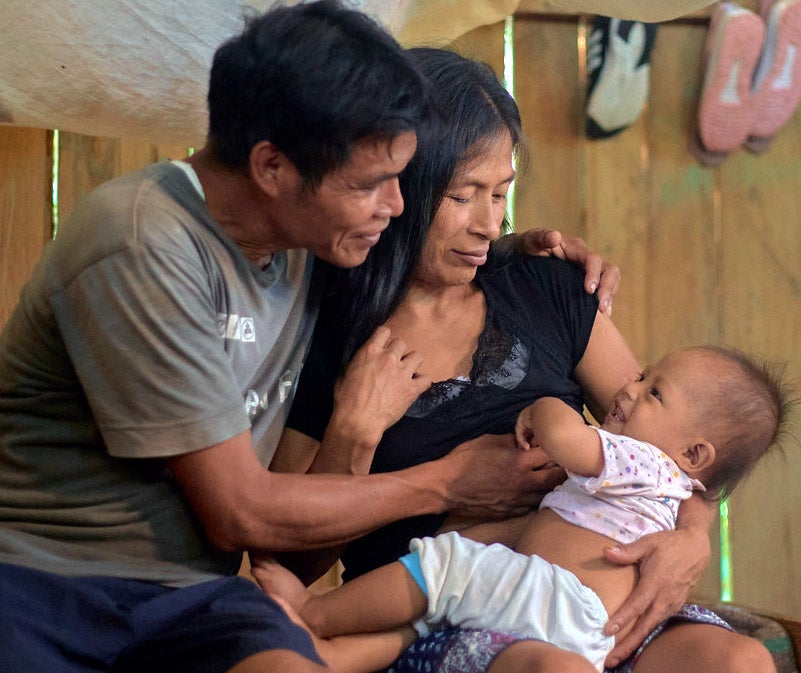 En la iniciativa también se prioriza los enfoques procedentes desde las perspectivas de la igualdad de género, los derechos humanos y los grupos en situación de vulnerabilidad, y se abordan los determinantes sociales de la salud según la definición de la OMS (“las circunstancias en que las personas nacen, crecen, trabajan, viven y envejecen, incluido el conjunto más amplio de fuerzas y sistemas que influyen sobre las condiciones de la vida cotidiana”) (4). La iniciativa se centra en los grupos que presentan una mayor carga de enfermedad debido a factores sociales, económicos y sistémicos complejos, como las mujeres, los Pueblos Indígenas, las personas afrodescendientes, las comunidades rurales, las personas LGBT, las personas migrantes y las personas en prisión. A medida que los países avanzan hacia la eliminación de enfermedades, la iniciativa ayuda a comprender y mejorar las condiciones subyacentes que obstaculizan la tarea en estas comunidades.
En la iniciativa también se prioriza los enfoques procedentes desde las perspectivas de la igualdad de género, los derechos humanos y los grupos en situación de vulnerabilidad, y se abordan los determinantes sociales de la salud según la definición de la OMS (“las circunstancias en que las personas nacen, crecen, trabajan, viven y envejecen, incluido el conjunto más amplio de fuerzas y sistemas que influyen sobre las condiciones de la vida cotidiana”) (4). La iniciativa se centra en los grupos que presentan una mayor carga de enfermedad debido a factores sociales, económicos y sistémicos complejos, como las mujeres, los Pueblos Indígenas, las personas afrodescendientes, las comunidades rurales, las personas LGBT, las personas migrantes y las personas en prisión. A medida que los países avanzan hacia la eliminación de enfermedades, la iniciativa ayuda a comprender y mejorar las condiciones subyacentes que obstaculizan la tarea en estas comunidades.
Figura 2. Marco conceptual: líneas de acción para la eliminación integrada de las enfermedades transmisibles en la Región de las Américas a lo largo del curso de vida

Las cuatro líneas de acción
Se establecieron cuatro líneas de acción para guiar la Iniciativa de Eliminación de Enfermedades, fortalecer la capacidad de los países y garantizar la sostenibilidad de la iniciativa, que se describen a continuación.
1 Fortalecer la integración de los sistemas de salud y la prestación de servicios de salud
Si bien los programas de salud verticales pueden ser efectivos para alcanzar algunas metas específicas, también pueden obstaculizar la atención de salud integral. En vista de ello, en la Iniciativa de Eliminación de Enfermedades se combinan múltiples intervenciones para distintas enfermedades en los servicios existentes y se adoptan enfoques innovadores, centrándose en el fortalecimiento de la atención primaria de la salud a nivel comunitario. Esta estrategia integral mejora la integración de los servicios en diversas áreas de la salud, aumenta la demanda de servicios de salud y fortalece los vínculos entre la comunidad y los servicios de salud, al tiempo que garantiza el acceso a medicamentos esenciales y tecnologías sanitarias. Al promover servicios de salud integrados y de buena calidad, este enfoque apoya el logro y el mantenimiento de las metas de eliminación de múltiples enfermedades y, de esta forma, mejora los resultados generales de salud para las personas y las comunidades.
2 Fortalecer los sistemas estratégicos de información y vigilancia de salud
Los sistemas de información para la salud suelen funcionar en compartimentos estancos, con una vigilancia fragmentada en los distintos sectores y una comunicación limitada entre el nivel comunitario, regional y nacional. La integración de estos sistemas puede crear eficiencias y sinergias para abordar múltiples enfermedades y condiciones relacionadas en la Iniciativa de Eliminación de Enfermedades. Esta integración requiere el fortalecimiento de la capacidad de los países para mejorar y unificar los sistemas de vigilancia, a fin de posibilitar la detección, la evaluación, el seguimiento y la notificación más eficaces de los datos sobre la salud en todas las áreas programáticas pertinentes. Además, la interoperabilidad de los sistemas de información para la salud es vital para la eliminación de enfermedades, ya que fortalece el flujo de información para mejorar la toma de decisiones y propicia una mayor continuidad de la atención y la colaboración transfronteriza necesaria para una labor regional eficaz de eliminación de enfermedades.
3 Abordar los determinantes sociales y ambientales de la salud
Las enfermedades transmisibles tienen un impacto desproporcionado en las comunidades con recursos limitados y otros grupos marginados. En general, las enfermedades comprendidas en la iniciativa están vinculadas a diversos determinantes sociales de la salud, como el acceso al agua potable y el saneamiento básico, las condiciones de vivienda, los riesgos del cambio climático, la inequidad de género, el estigma y la discriminación, diversos factores socioculturales y la pobreza, entre otros. Incluso las intervenciones costo-eficaces y basadas en la evidencia contra las enfermedades transmisibles —por ejemplo, las vacunas— tienen un impacto limitado si no se afrontan las inequidades en materia de salud relacionadas con los determinantes sociales y ambientales. Por lo tanto, en las intervenciones centradas en las personas es necesario hacer frente a las causas fundamentales de las disparidades. Esto puede ayudar a romper los ciclos de pobreza (y otras fuentes de inequidad) y, al mismo tiempo, a abordar de manera más eficaz la eliminación de múltiples enfermedades.
4 Fortalecer la gobernanza, la rectoría y las finanzas
Para implementar plenamente los programas de salud integrados, es esencial promover y normalizar la colaboración intersectorial, no solo entre diferentes instituciones públicas (por ejemplo, instituciones de salud, educación y finanzas), sino también entre los sectores no gubernamentales. A fin de coordinar a los diversos asociados, este proceso debe incluir un diálogo con el sector privado y la sociedad civil, así como con diversos sectores gubernamentales. Esto permitirá a las autoridades de salud definir funciones y responsabilidades claras para cada uno de los agentes que participan en la agenda de eliminación de enfermedades transmisibles. En particular, es crucial fortalecer el liderazgo de las jurisdicciones provinciales, departamentales y municipales, así como de la sociedad civil por medio de acuerdos gubernamentales, en el proceso de toma de decisiones, para que las iniciativas e intervenciones en materia de salud se adapten al contexto comunitario.
Recuadro 3. Ejemplos de medidas adoptadas en el marco de la Iniciativa de Eliminación de Enfermedades
Fortalecer la integración de los sistemas de salud y la prestación de servicios de salud
- Desarrollar la capacidad de los trabajadores de atención primaria en una variedad de temas relacionados con la salud para que puedan detectar y resolver múltiples problemas (detección, diagnóstico y tratamiento) en una sola consulta.
- Fortalecer los servicios de laboratorio y de diagnóstico a nivel comunitario.
- Mejorar la planificación, la compra y el suministro de insumos de salud pública, como vacunas y antivirales, para los programas nacionales.
Fortalecer los sistemas estratégicos de información y vigilancia de salud
- Hacer un mapeo combinado de todas las enfermedades y condiciones comprendidas en la iniciativa a fin de determinar mejor los patrones, orientar los recursos de manera efectiva y coordinar eficazmente las estrategias dirigidas a múltiples enfermedades.
- Ofrecer capacitación y consultas para quienes administran información sobre la salud y sistemas de vigilancia ambiental.
- Proporcionar información periódica a todas las partes interesadas sobre los avances en la hoja de ruta para la eliminación.
Abordar los determinantes sociales y ambientales de la salud
- Promover la participación de la sociedad civil en la gobernanza, así como en la planificación y el mapeo participativos a nivel local, a fin de determinar las principales vías para la eliminación de enfermedades transmisibles.
- Fomentar enfoques multiculturales como parte del empoderamiento de la comunidad.
- Mejorar la colaboración intersectorial para abordar diversas cuestiones, desde el acceso a servicios básicos de agua y saneamiento hasta la gestión de residuos sólidos, además de la mejora de la vivienda, entre otras.
Fortalecer la gobernanza, la rectoría y las finanzas
- Fortalecer la confianza y las alianzas con los gobiernos municipales y la sociedad civil para alcanzar las metas de la Iniciativa de Eliminación de Enfermedades.
- Movilizar recursos locales, subregionales y regionales para garantizar la sostenibilidad de las actividades relacionadas con las enfermedades transmisibles.
- Mejorar los compromisos financieros para aumentar el acceso a tecnologías sanitarias costo efectivas e innovadoras.
Hitos y logros regionales decisivos: de 1902 al presente
Recuadro 4. La OPS tiene una trayectoria arraigada de eliminación de enfermedades
En 1870, una epidemia de fiebre amarilla azotó a Argentina, Brasil, Paraguay y Uruguay, y en ocho años llegó a Estados Unidos, donde causó la muerte de más de 20 000 personas. El transporte marítimo, que se estaba extendiendo con rapidez, junto con el comercio internacional, era el principal canal de propagación internacional de enfermedades a fines del siglo XIX. Esta necesidad de proteger la salud de las personas y las economías de los países mediante el control de la transmisión de la fiebre amarilla en la Región de las Américas llevó a la creación en diciembre de 1902 de lo que hoy se conoce como la OPS.
La rica trayectoria de la OPS de lucha contra enfermedades transmisibles
Desde que se fundó la OPS en 1902, la Región ha avanzado mucho hacia la eliminación de enfermedades. Entre los primeros logros notables se encuentran los avances sustanciales contra la fiebre amarilla, en particular a principios del siglo XX, después que se descubrió que se transmitía por mosquitos. Otro hito temprano fue el reconocimiento en el Código Sanitario Panamericano, ratificado en 1924 y aún vigente, de que la salud es un derecho de todos los países y de todas las personas.
Si bien las vacunas contra la rabia y la viruela ya se habían introducido en la Región en el siglo XIX, para mediados del siglo XX ya se disponía de varias vacunas más, como la vacuna contra la difteria, el tétanos y la tos ferina (en la década de 1920); la vacuna contra la fiebre amarilla (en la década de 1930); la vacuna contra la gripe (en la década de 1940), y la vacuna contra la poliomielitis (en la década de 1950). Aunque la disponibilidad y la adopción variaban mucho, en la Región comenzaron a verse reducciones drásticas de algunas enfermedades transmisibles a mediados del siglo XX. Otros logros importantes durante las primeras décadas de la OPS fueron las exitosas campañas de control de vectores a partir de los años cuarenta. En 1946 se aprobó una resolución para erradicar el mosquito Aedes aegypti (vector de la fiebre amarilla y otras enfermedades) en la Región, y para la década de 1960 se lo había eliminado en varios países. La prevalencia de la malaria también disminuyó mucho, gracias en gran parte a las medidas de control de mosquitos que comenzaron en la década de 1940 y al inicio de una ambiciosa campaña en 1954. Aunque no se logró eliminar la enfermedad de Chagas por completo, se avanzó considerablemente en su control con la mejora de las viviendas y el uso de insecticidas.
A principios de la década de 1950 se afianzó en la Región de las Américas el concepto de la erradicación de ciertas enfermedades infecciosas, en particular aplicado a la malaria, la fiebre amarilla e incluso la tuberculosis. Además, las campañas contra el pian en los años cincuenta y sesenta llevaron a la enfermedad al borde de la eliminación en muchos países. En la década de 1960, los líderes de la OPS comenzaron a hablar sobre la importancia de integrar y fortalecer los servicios de salud, lo cual influyó mucho en las campañas de eliminación de enfermedades que vendrían más adelante.
Esfuerzos renovados para acelerar la eliminación de enfermedades
Con el tiempo, se eliminó en la Región de las Américas la viruela en 1973 (y se la erradicó en 1980). En 1994 se certificó que la Región estaba libre de poliomielitis, después de decenios de trabajo para controlar la epidemia. En los últimos decenios, la Región ha seguido avanzando hacia la eliminación de la malaria y de varias enfermedades infecciosas desatendidas, como la lepra, la filariasis linfática y la oncocercosis (ceguera de los ríos). En muchos países también se lograron grandes reducciones en relación con la enfermedad de Chagas, las geohelmintiasis, la esquistosomiasis y la fascioliasis en la población infantil y en otros grupos en riesgo. Además, uno de los mejores casos de éxito mundial con la eliminación de la transmisión maternoinfantil se produjo en la Región de las Américas. En el 2015, la OPS y la OMS confirmaron que Cuba era el primer país del mundo en haber eliminado la transmisión maternoinfantil del VIH y la sífilis (5). En los últimos diez años también se han eliminado la rubéola, el síndrome de rubéola congénita y el tétanos neonatal en la Región.
Desde que se fundó la OPS, su apoyo técnico y poder de convocatoria han sido cruciales para unir a diversas partes interesadas en torno a la misión común de eliminar enfermedades. Estos logros fueron el resultado de la colaboración entre la OPS y sus Estados Miembros, con el firme compromiso de los gobiernos, los trabajadores de salud, las comunidades, los asociados y los donantes. Sobre la base de más de un siglo de sólida evidencia científica, la OPS hizo un firme llamado a la acción y aprovechó los logros pasados al poner en marcha la Iniciativa de Eliminación de Enfermedades.
Recuadro 5. Los compromisos que condujeron a la Iniciativa de Eliminación de Enfermedades
Esta iniciativa no representó de ninguna manera el primer compromiso de eliminar enfermedades en la Región de las Américas. En los últimos decenios, en particular, los Estados Miembros de la OPS aprobaron docenas de resoluciones para eliminar enfermedades, incluso algunas que abarcaban varias. A continuación se presentan algunos ejemplos de estas resoluciones y de los compromisos asumidos en la Región:
- En 1990 se aprobó una resolución de la OPS para eliminar varias enfermedades —poliomielitis, sarampión, tétanos neonatal, rabia y fiebre aftosa— para el año 2000.
- A partir del año 2000, los esfuerzos de la OPS y de los Estados Miembros para alcanzar los Objetivos de Desarrollo del Milenio fueron fundamentales para seguir avanzando hacia la eliminación de enfermedades.
- En una resolución del 2009, la OPS hizo un llamamiento a la eliminación o el control de 12 enfermedades infecciosas desatendidas en la Región de las Américas para el 2015.
- En el 2010, los Estados Miembros de la OPS aprobaron una resolución para eliminar la transmisión maternoinfantil del VIH y la sífilis.
- En el 2015, la Consulta Regional sobre la Eliminación de Enfermedades en la Región de las Américas movilizó a los Estados Miembros en torno a este tema y sentó las bases de la Iniciativa de Eliminación de Enfermedades.
- En un plan de acción del 2016 se recomendaba la prevención, el control y la reducción de la carga de enfermedad relacionada con varias enfermedades infecciosas desatendidas.
Debido a la continuidad de estos compromisos y a la intensa labor realizada en toda la Región para aumentar las tasas de vacunación, reforzar las capacidades de los países, fortalecer los sistemas de salud y aumentar el financiamiento interno, para el 2019, cuando se puso en marcha la Iniciativa de Eliminación de Enfermedades, estas actividades ya estaban cobrando impulso. Sin embargo, estas resoluciones ofrecían apenas una parte de la solución y abarcaban solo ciertos grupos de enfermedades. La iniciativa presentaba un marco más amplio y audaz para eliminar varias enfermedades en múltiples frentes.
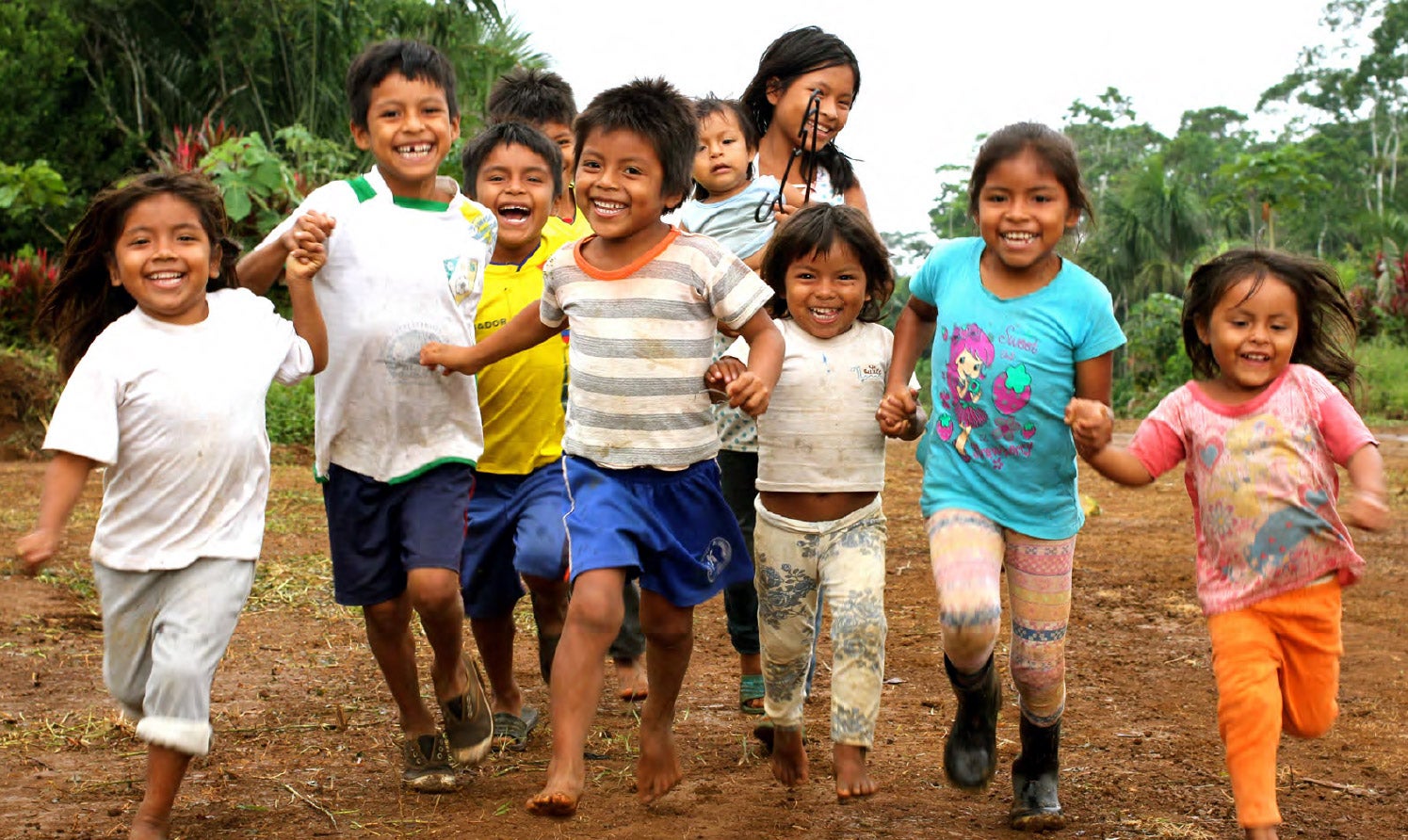 © OPS
© OPS
Enfoques procedentes de actividades anteriores para eliminar enfermedades
A lo largo del tiempo, la OPS y sus Estados Miembros han documentado experiencias y conocimientos prácticos relacionados con la eliminación de enfermedades, que sirven de base para esta iniciativa y sus líneas de acción. A continuación se resumen algunas de las principales enseñanzas y enfoques incorporados en la iniciativa.
Beneficios de los programas integrados
Tradicionalmente, las actividades de eliminación de enfermedades se concentraban en una enfermedad por vez. Si bien es cierto que cada enfermedad debe entenderse por separado (y analizar los modos de transmisión, el tratamiento eficaz, las vacunas, etc.), afrontar cada enfermedad de manera aislada puede limitar la eficacia de la tarea. Al examinar varias enfermedades al mismo tiempo, los Estados Miembros han encontrado desafíos comunes relacionados con políticas, programas y servicios. Por ejemplo, las enfermedades prevenibles por vacunación a menudo tienen en común factores de riesgo, modos de transmisión, insumos y medidas de prevención. Los sistemas de salud que tienen un enfoque más integrado con respecto a los programas de lucha contra las enfermedades pueden ser más efectivas para alcanzar objetivos comunes.
Con el tiempo, la OPS y sus Estados Miembros se dieron cuenta de la necesidad de encontrar soluciones y planificar programas para combatir múltiples enfermedades al mismo tiempo. En el 2015, la OPS convocó la Consulta Regional sobre la Eliminación de Enfermedades en la Región de las Américas para examinar el avance de las medidas de eliminación y agrupar varios mandatos y estrategias centrados en determinadas enfermedades transmisibles en un conjunto integrado. En la consulta se pusieron de relieve numerosas sinergias y oportunidades para la colaboración e integración de programas de eliminación de enfermedades, así como para reducir la fragmentación, mejorar la costo-efectividad y atender mejor las necesidades de las comunidades. Por ejemplo, los programas pueden aprovechar los medios de diagnóstico en común, con el uso de las mismas plataformas de muestreo y pruebas para diagnosticar múltiples enfermedades de manera eficiente (lo cual no solo reduce los costos, sino que también garantiza el diagnóstico oportuno y preciso de diversas afecciones). En resumen, los expertos que participaron en esta consulta reconocieron la importancia de la integración en todos los niveles: servicios de atención, de laboratorio y de diagnóstico; capacitación de prestadores; sistemas de información, etc.6. Esta reunión fue la piedra angular de la Iniciativa de Eliminación de Enfermedades.
Estos conocimientos sirvieron de base para la línea estratégica de acción 1 de la iniciativa: fortalecer la integración de los sistemas de salud y la prestación de servicios de salud.
Necesidad de contar con sistemas más sólidos de intercambio de conocimientos e información
A lo largo de los decenios, a medida que la OPS y sus Estados Miembros hacían el seguimiento de distintas enfermedades y afecciones, se dieron cuenta de la necesidad de contar con sistemas sólidos de recopilación de datos para transmitir e intercambiar información y conocimientos de manera eficaz. En la consulta regional del 2015 se indicó la necesidad de una agenda de investigación centrada en la superación de obstáculos, con soluciones que pudieran usarse de inmediato en el terreno para ayudar a los países a alcanzar los objetivos de la eliminación de enfermedades. También se señaló la necesidad de contar con datos de vigilancia de buena calidad6.
Sin sistemas de vigilancia oportunos y eficientes que abarquen todos los niveles del sistema de salud, desde el nivel local hasta el nacional y regional, los Estados Miembros no pueden tomar decisiones fundamentadas relacionadas con las políticas, el financiamiento y los servicios. Los sistemas de datos más sólidos pueden ayudarnos a saber dónde están las lagunas: podemos ver qué grupos se están quedando atrás, para qué enfermedades no se están alcanzando las metas y dónde se necesitan recursos adicionales. La tecnología avanza constantemente, y los Estados Miembros ahora tienen acceso a sistemas digitales de salud e intercambio de datos más sofisticados. La Iniciativa de Eliminación de Enfermedades está ayudando a fortalecer estos sistemas para que se pueda usar la evidencia de una manera más eficaz.
Estos conocimientos sirvieron de base para la línea de acción 2 de la iniciativa: fortalecer los sistemas estratégicos de información y vigilancia de salud.
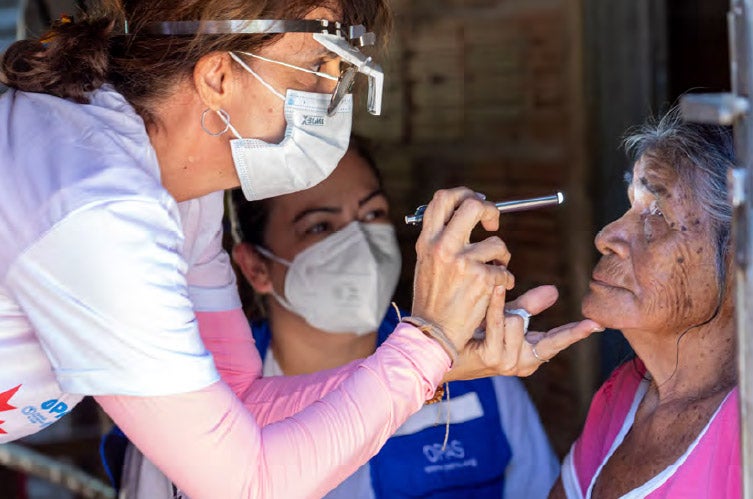 Importancia de abordar la salud de manera integral
Importancia de abordar la salud de manera integral
Con el tiempo, los Estados Miembros han aprendido que las diferencias en la carga de enfermedad suelen estar relacionadas con los determinantes sociales de la salud. Específicamente, muchas enfermedades y afecciones tienen un impacto mayor en los grupos poblacionales en situación de vulnerabilidad, marginados socioeconómicamente o con dificultades para acceder a los servicios de salud. Un ejemplo es el tracoma, que afecta con mayor frecuencia a las personas que viven en la pobreza extrema. En su transmisión influyen determinantes sociales y ambientales, como las condiciones sanitarias, la higiene y el hacinamiento7. Otro ejemplo es la tuberculosis: los ambientes hacinados y mal ventilados y la desnutrición, que están vinculados a la pobreza, constituyen factores de riesgo directos de transmisión de la tuberculosis8. Al adaptar las intervenciones a grupos específicos, los sistemas de salud pueden garantizar que las medidas para eliminar enfermedades sean inclusivas y accesibles, y que respondan a las diversas necesidades de todos los miembros de la comunidad, en particular de aquellas personas que a menudo se pasan por alto en los sistemas de salud tradicionales.
Además de tener en cuenta los determinantes sociales y ambientales de la salud, la iniciativa se basó en datos programáticos de varios años que muestran la importancia de tener en cuenta las diferentes etapas del curso de vida. Por ejemplo, las mujeres embarazadas corren un mayor riesgo de sufrir síntomas graves cuando contraen ciertas infecciones, como sarampión o malaria.
Estos conocimientos sirvieron de base para la línea de acción 3 de la iniciativa: abordar los determinantes sociales y ambientales de la salud.
Beneficios de un enfoque multisectorial
La OPS ocupa una posición única que le permite convocar a las partes interesadas y mantener el ímpetu hacia la eliminación de enfermedades. A lo largo de los años, la OPS y sus asociados han formado coaliciones de científicos y grupos consultivos técnicos relacionados con una variedad de enfermedades, desde la tuberculosis hasta la infección por el VIH y la enfermedad de Chagas. Además, la OPS facilita la colaboración multisectorial entre los gobiernos, los financiadores, el sector privado, las comunidades, las organizaciones de la sociedad civil y otros. Entre otros beneficios, esta colaboración ayuda a reducir los costos de insumos y vacunas para los Estados Miembros. Por ejemplo, por medio de los Fondos Rotatorios Regionales, la OPS mejoró el acceso a la vacuna contra el virus del papiloma humano (VPH), que es crucial para prevenir el cáncer cervicouterino. A fines de la primera década del presente siglo, la OPS, en colaboración con productores privados, negoció en nombre de los países participantes una reducción del precio de la vacuna contra el VPH de más de USD 120 por dosis en el 2007 a menos de USD 109.
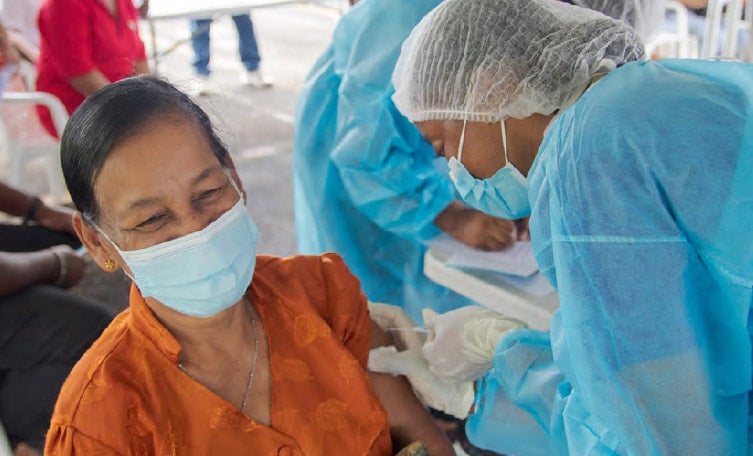 Este logro ejemplificó el impacto de los esfuerzos multisectoriales encaminados a mejorar la accesibilidad y asequibilidad de los insumos esenciales de salud para los Estados Miembros de la OPS.
Este logro ejemplificó el impacto de los esfuerzos multisectoriales encaminados a mejorar la accesibilidad y asequibilidad de los insumos esenciales de salud para los Estados Miembros de la OPS.
Otras alianzas multisectoriales en los Estados Miembros también han demostrado ser esenciales para la tarea de eliminación de enfermedades. Por ejemplo, en el ámbito de la prevención y el tratamiento de la infección por el VIH, se formaron alianzas multisectoriales integradas por diversas partes interesadas, como gobiernos, organizaciones no gubernamentales, empresas, prestadores de atención de salud, instituciones de enseñanza y organizaciones confesionales. Estas colaboraciones permitieron adoptar un enfoque más integral al combinar recursos, pericia y alcance para afrontar simultáneamente diversos aspectos de la epidemia. En los últimos decenios, estas alianzas facilitaron una difusión más amplia de información sobre prevención, mejoraron el acceso a pruebas y tratamientos, y ayudaron a combatir el estigma mediante la acción coordinada de diferentes sectores de la sociedad.
Estos conocimientos constituyeron la base de la línea de acción 4 de la iniciativa: fortalecer la gobernanza, la rectoría y las finanzas.
Barreras y brechas
En la Iniciativa de Eliminación de Enfermedades se aprovechan los años de experiencia con la mejora de los sistemas de salud y el fomento de la cooperación entre diferentes sectores. Sin embargo, hay varios obstáculos que pueden dificultar los avances hacia los objetivos de la iniciativa:
- Migración: el movimiento de las personas, tanto dentro de los países de la Región como entre ellos, puede tener un impacto considerable en la eliminación de enfermedades. Las principales cuestiones son la posibilidad de transmisión de enfermedades a través de las fronteras, el menor acceso de las personas migrantes a la atención de salud, la falta de servicios de atención culturalmente sensibles, y las dificultades del seguimiento y la gestión de las actividades de prevención y tratamiento en comunidades móviles y transfronterizas.
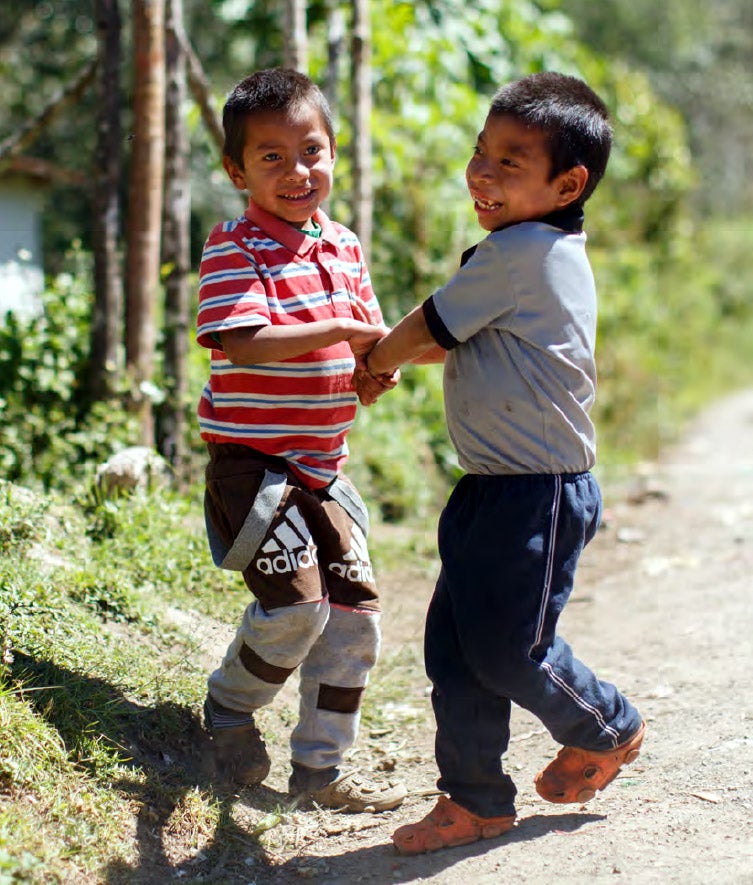
- Aumento de las enfermedades no transmisibles: el aumento de las enfermedades no transmisibles (ENT) se ha convertido en uno de los problemas más apremiantes para la Región de las Américas en los últimos años10. Algunos ejemplos de ENT son la diabetes, las enfermedades cardíacas, los accidentes cerebrovasculares, el cáncer y las enfermedades pulmonares crónicas11. Además de competir por fondos limitados, las ENT a menudo pueden crear complicaciones para el tratamiento de enfermedades transmisibles, en particular las infecciones crónicas.
- Inequidades existentes en la salud: en las publicaciones se señala que los grupos que enfrentan desigualdades sociales y económicas corren un riesgo sistemáticamente mayor de contraer enfermedades transmisibles12. Las comunidades marginadas son más vulnerables a estas enfermedades debido a una compleja interacción de factores, entre ellos el acceso limitado a la atención de salud, malas condiciones de vida, disparidades económicas, menor alfabetización en materia de salud y la negligencia sistémica derivada de la discriminación y la falta de representación política. Además, en estas comunidades, las enfermedades pueden exacerbar las condiciones de desigualdad y llevar a un círculo vicioso.
- Estigma y discriminación: entre los grupos que a menudo enfrentan estigma y discriminación relacionados con la atención de salud se encuentran las personas LGBT (particularmente las personas trans), las comunidades indígenas, las personas inmigrantes indocumentadas, los trabajadores sexuales y las personas que tienen ciertas enfermedades transmisibles (por ejemplo, infección por el VIH, tuberculosis y hepatitis), así como una variedad de otros grupos. El estigma y la discriminación en el ámbito de la atención de salud pueden obstaculizar la labor general de eliminación de enfermedades porque disuaden a las personas afectadas de buscar atención (o no permiten que reciban un tratamiento eficaz cuando buscan atención), lo cual provoca retrasos en el diagnóstico y el tratamiento, una menor adhesión a los esquemas de tratamiento con medicamentos y la divulgación incompleta de información sobre su salud a los prestadores de servicios.
- Impacto del cambio climático: el cambio climático puede afectar los esfuerzos de la Iniciativa de Eliminación de Enfermedades de varias maneras. Los cambios en la temperatura, las precipitaciones y la humedad pueden incidir en la transmisión de enfermedades por vectores. El cambio climático también puede llevar a la aparición de nuevos agentes patógenos, al alterar las pautas meteorológicas y los hábitats, e influir en la extensión, la duración y la intensidad de las enfermedades infecciosas13, 14. Además, puede exacerbar las condiciones de desigualdad y, de esta forma, aumentar el riesgo de contraer enfermedades transmisibles.
- Interacción entre los seres humanos, los animales y el medioambiente: la eliminación de zoonosis desatendidas, como la rabia, y la caracterización de los reservorios selváticos y de vectores de enfermedades epidemiógenas, como la fiebre amarilla y la peste, requieren una vigilancia integrada e intervenciones coordinadas, lo que se puede abordar mediante el enfoque de “Una salud”.
- Limitaciones de recursos: puede ser difícil mantener las actividades de eliminación de enfermedades en entornos donde los recursos son limitados. Es posible que el financiamiento se proporcione de manera aislada y no sea suficiente, y las enfermedades transmisibles plantean grandes dificultades para los presupuestos públicos de salud, ya de por sí sobrecargados, que enfrentan una gama cada vez mayor de amenazas para la salud, entre ellas la incidencia cada vez mayor de las ENT y los efectos del cambio climático en la salud. Además, gran parte de la agenda y el financiamiento mundiales se han dirigido a ciertas enfermedades de gran resonancia, como la infección por el VIH, la tuberculosis y la malaria, mientras que otras, como las enfermedades infecciosas desatendidas y las zoonosis, han quedado fuera.
- Nuevas enfermedades transmisibles, incluida la COVID-19: como ocurrió en todo el mundo, la pandemia de COVID-19 puso de relieve y amplificó la necesidad de fortalecer los sistemas y servicios de salud en la Región de las Américas. Cuando surgen nuevas enfermedades, los países a menudo deben desviar recursos y esfuerzos para prestarles atención, lo cual aminora el progreso hacia la eliminación de enfermedades existentes15. Además, las nuevas enfermedades con frecuencia pueden contribuir a una “sindemia”, una situación en la que dos o más enfermedades o condiciones de salud interactúan sinérgicamente y contribuyen a un exceso de carga de enfermedad en una población.
- Resistencia a los antimicrobianos: la resistencia a los antimicrobianos amenaza la prevención y el tratamiento eficaces de diversas enfermedades infecciosas causadas por bacterias, parásitos, virus y hongos (incluidas muchas de las más de 30 enfermedades incluidas en la iniciativa). En particular, reduce la eficacia de los fármacos utilizados para tratar infecciones, lo cual podría dificultar o imposibilitar el control de enfermedades que antes eran manejables o curables, y permite que se propaguen cepas patógenas resistentes. Esto puede socavar en gran medida el progreso hacia las metas de eliminación.
Oportunidades
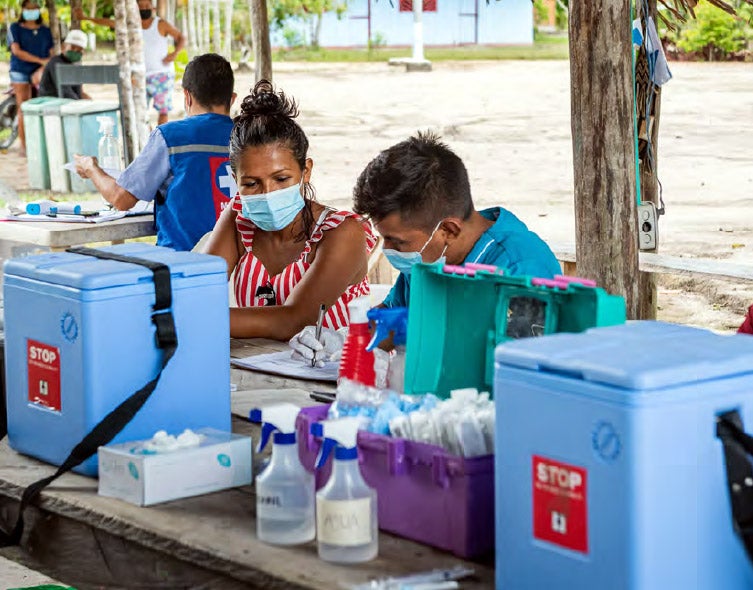 A pesar de enfrentar desafíos, la Región también tiene muchas oportunidades para eliminar muchas enfermedades transmisibles. La integración de los servicios de salud, con énfasis en la atención primaria, es una prioridad para los gobiernos en general (más allá de las enfermedades transmisibles), pero puede aprovecharse para la eliminación de enfermedades transmisibles. Las estrategias transversales de aumento de la capacidad, entre ellas los Fondos Rotatorios Regionales, ofrecen un apoyo crítico para garantizar la distribución oportuna y eficiente de medicamentos y tecnologías sanitarias en la Región. Al respecto, el enfoque de la soberanía sanitaria en la Región de las Américas está ayudando a fortalecer la producción regional de vacunas, medicamentos e insumos de salud pública, lo cual ayuda a garantizar el acceso a estos productos críticos.
A pesar de enfrentar desafíos, la Región también tiene muchas oportunidades para eliminar muchas enfermedades transmisibles. La integración de los servicios de salud, con énfasis en la atención primaria, es una prioridad para los gobiernos en general (más allá de las enfermedades transmisibles), pero puede aprovecharse para la eliminación de enfermedades transmisibles. Las estrategias transversales de aumento de la capacidad, entre ellas los Fondos Rotatorios Regionales, ofrecen un apoyo crítico para garantizar la distribución oportuna y eficiente de medicamentos y tecnologías sanitarias en la Región. Al respecto, el enfoque de la soberanía sanitaria en la Región de las Américas está ayudando a fortalecer la producción regional de vacunas, medicamentos e insumos de salud pública, lo cual ayuda a garantizar el acceso a estos productos críticos.
El reconocimiento cada vez mayor de la importancia de la participación comunitaria y de la investigación con participación comunitaria ofrece algunas posibles soluciones para los desafíos actuales, en particular los relacionados con la satisfacción de las necesidades de los grupos marginados y la creación de demanda de servicios relacionados con las enfermedades objetivo. La mejora de la tecnología también constituye una herramienta importante e innovadora para la vigilancia, el tratamiento, la integración y el manejo de enfermedades. A medida que los gobiernos toman más conciencia de los determinantes sociales de la salud, pueden satisfacer de manera más efectiva las necesidades integrales de las personas y ayudar a romper el círculo vicioso del riesgo de enfermedad en las comunidades marginadas.
Además, el concepto de la Iniciativa de Eliminación de Enfermedades en sí presenta una gran oportunidad. “Eliminación” es un mensaje contundente que puede atraer a los gobiernos y a los políticos, y ofrecerles una forma de mostrar resultados y producir un cambio real. Esto puede despertar interés y generar compromisos políticos.
Por último, si bien la pandemia de COVID-19 planteó grandes desafíos para los sistemas de salud en toda la Región, también ofreció algunas oportunidades únicas. Por un lado, aumentó considerablemente la conciencia de la importancia de la salud para la estabilidad social, económica y política. También aceleró la adopción de ciertas innovaciones relacionadas con la prestación de servicios. Esto creó oportunidades extraordinarias para aplicar estas innovaciones en los desafíos futuros para la salud15.
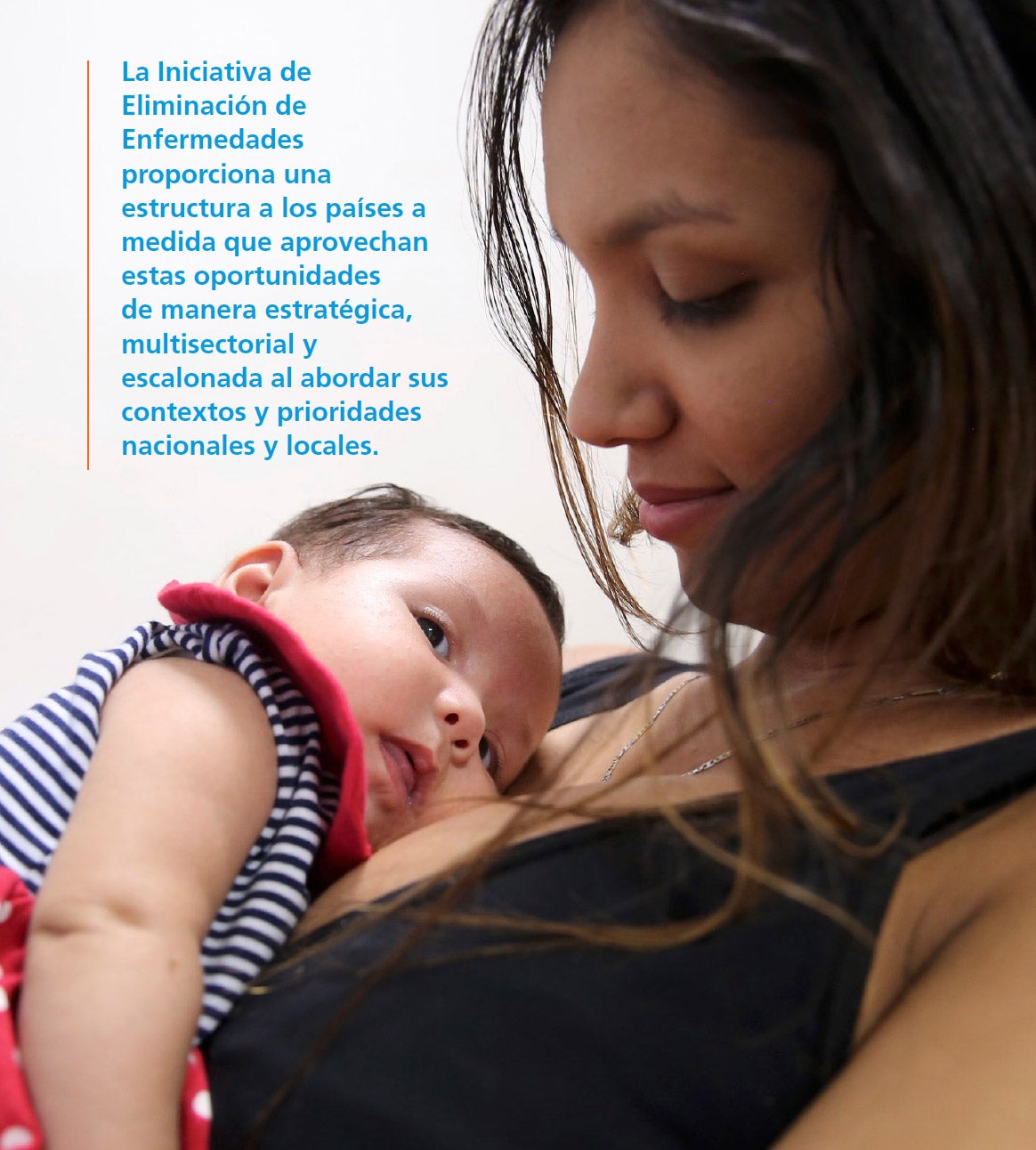

Haz clic aquí para ver la imágen en tamaño real
Referencias
- Organización Panamericana de la Salud. Marco sostenible e integrado para la eliminación de enfermedades transmisibles en la Región de las Américas. Nota conceptual. Washington, D.C.: OPS; 2019. Disponible en: https://iris.paho.org/handle/10665.2/51107.
- Organización Panamericana de la Salud. Iniciativa de la OPS para la eliminación de enfermedades: política para aplicar un enfoque integrado y sostenible de las enfermedades transmisibles en la Región de las Américas [resolución CD57.R7]. 57.o Consejo Directivo de la OPS, 71.a sesión del Comité Regional de la OMS para las Américas; del 30 de septiembre al 4 de octubre del 2019. Washington, D.C.: OPS; 2019. Disponible en: https://iris. paho.org/handle/10665.2/58140.
- Organización Mundial de la Salud. Eighth report of the Strategic and Technical Advisory Group for Neglected Tropical Diseases (STAG-NTDs). Ginebra: OMS; 2015. Disponible en: https://www.who.int/publications/m/item/eighth-report-of-the-strategic-and-technical-advisory-group-for-neglected-tropical-diseases-(stag-ntds).
- 4. Organización Panamericana de la Salud. Determinantes sociales de la salud. Washington, D.C.: OPS [fecha desconocida] [consultado el 16 de agosto del 2024]. Disponible en: https://www.paho.org/es/temas/determinantes-sociales-salud.
- Caffe S, Pérez F, Kamb ML, Gómez Ponce de León R, Alonso M, Midy R, et al. Cuba validated as the first country to eliminate mother-to-child transmission of human immunodeficiency virus and congenital syphilis: lessons learned from the implementation of the global validation methodology. Sex Transm Dis. 2016; 43(12):733–736. Disponible en: https://doi.org/10.1097/olq.0000000000000528.
- Organización Panamericana de la Salud. Regional consultation on disease elimination in the Americas. Washington, D.C.: OPS; 2015. https://www.paho.org/en/documents/regionalconsultation-disease-elimination-americas.
- Organización Panamericana de la Salud. OPS y Canadá unen esfuerzos para eliminar el tracoma en América Latina y el Caribe. Washington, D.C.: OPS; 2023 [consultado el 16 de agosto del 2024]. Disponible en: https://www.paho.org/es/noticias/22-9-2023-ops-canada-unen-esfuerzos-para-eliminar-tracoma-america-latina-caribe.
- Organización Mundial de la Salud. Global Tuberculosis Programme: social determinants. Ginebra: OMS; c2023 [consultado el 16 de agosto del 2024]. Disponible en: https://www.who.int/teams/globaltuberculosis-programme/populations-comorbidities/social-determinants.
- Organización Panamericana de la Salud. Fondo Rotatorio de la OPS. Washington, D.C.: OPS; 2024 [consultado el 16 de agosto del 2024]. Disponible en: https://www.paho.org/es/fondo-rotatorio.
- GBD 2019 Diseases and Injuries Collaborators. Global burden of 369 diseases and injuries, 1990–2019: a systematic analysis for the Global Burden of Disease Study 2019. Lancet. 2020;396(10258):1204–1222. Disponible en: https://doi.org/10.1016/S0140-6736(20)30925-9.
- Hambleton IR, Caixeta R, Jeyaseelan SM, Luciani S, Hennis AJM. The rising burden of noncommunicable diseases in the Americas and the impact of population aging: a secondary analysis of available data. Lancet Reg Health Am. 2023;21:100483. Disponible en: https://doi.org/10.1016/j.lana.2023.100483.
- Ayorinde A, Ghosh I, Ali I, Zahair I, Olarewaju O, Singh M, et al. Health inequalities in infectious diseases: a systematic overview of reviews. BMJ Open. 2023;13(4):e067429. Disponible en: https://doi.org/10.1136/bmjopen-2022-067429.
- Organización Panamericana de la Salud. Cambio climático y salud. Washington, D.C.: OPS [fecha desconocida] [consultado el 16 de agosto del 2024]. Disponible en: https://www.paho.org/es/temas/cambio-climatico-salud.
- Yglesias-Gonzalez M, Palmeiro-Silva Y, Sergeeva M, Cortés S, Hurtado-Epstein A, Buss DF, et al. Code Red for Health response in Latin America and the Caribbean: enhancing peoples’ health through climate action. Lancet Reg Health Am. 2022;11:100248. Disponible en: https://doi.org/10.1016/j.lana.2022.100248.
- Espinal MA, Alonso M, Sereno L, Escalada R, Saboya M, Ropero AM, et al. Sustaining communicable disease elimination efforts in the Americas in the wake of COVID-19. Lancet Reg Health Am. 2022;13:100313. Disponible en: https://doi.org/10.1016/j.lana.2022.100313.
TEMA ACTUAL
CAPÍTULOS
- Informe Ejecutivo
- Panorama de la Iniciativa de Eliminación de Enfermedades
- Progreso regional hacia las metas de eliminación de enfermedades
- Perspectivas sobre las intervenciones relacionadas con enfermedades específicas
- Acelerar los esfuerzos de eliminación de enfermedades en la Región
- Lograr la eliminación




